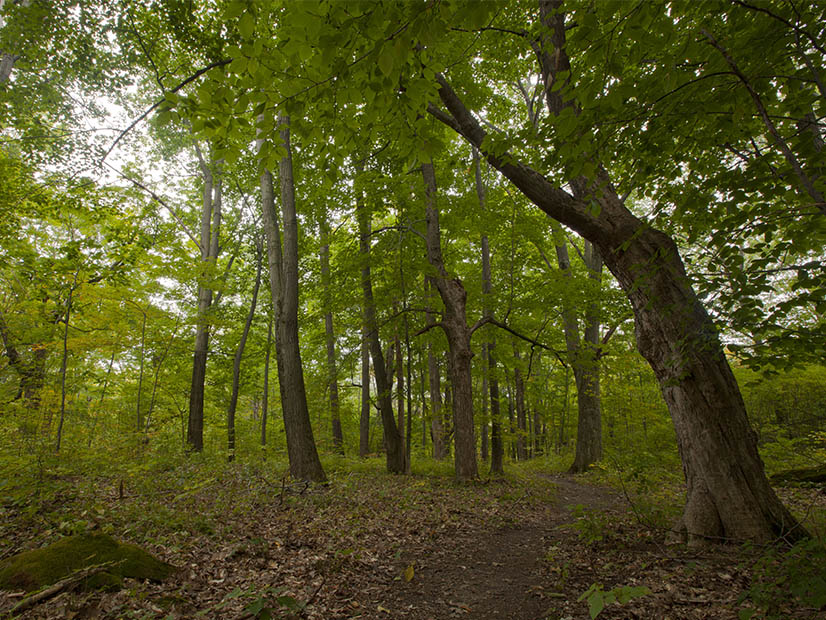
Small towns in Massachusetts are approving large-scale solar projects to generate renewable energy for their communities and help the state reach its goal of a 50% reduction in emissions by 2030, but locals are losing forested areas and high-quality farmland in the process.
The planning board in Northfield, Mass., has approved permits for three solar arrays on 76 acres of farmland. Just south of Northfield, Shutesbury is considering a 190-acre solar project on forested land.
In southeastern Massachusetts, Wareham’s planning board approved a solar field on 157 acres of forest.
Northwestern Massachusetts, part of the Connecticut River Valley, is known for its old-growth forests and rich soil, which has supported cultivation for hundreds of years.
Statewide rallies held at the end of July by various conservation grassroots movements called for a moratorium on solar projects larger than five acres that propose building on productive farmland or clear-cutting trees in places where species need to be protected.
“We have to look at everything holistically,” said Meg Sheehan, a rally organizer and member of the nonprofit conservation advocacy group Save the Pine Barrens. “We shouldn’t be rushing through this blindly to get to net zero by 2050.”
Using satellite imagery, Mass Audubon found that in Massachusetts and Rhode Island 4,000 acres of private forest land have been cleared for solar arrays, threatening biodiversity in the states.
Building on farmland also reduces local food production and increases communities’ reliance on produce from cross-country trucking, which expels greenhouse gases.
“We are killing the environment to save it,” said Janet Sinclair, another rally organizer and Save the Pine Barrens member.
A moratorium on solar subsidies for developments on forested areas or agricultural land should be in place until the Massachusetts Department of Energy Resources (DOER) changes state laws to encourage building solar arrays on parking lots or landfills instead, Sinclair said.
Currently, it is more profitable to build on open space than in the built environment. It should be up to the state to create laws that make solar developments in parking lots more profitable, since the developments help meet state climate goals, Sinclair said.
“Developers are just following the money,” she said.
The DOER did not respond to requests for comment on the call for the moratorium or on the future of solar development in the state.
Several Massachusetts towns, including Shutesbury, have strong bylaws in place to protect forested areas. Amp Energy, the Canadian company developing the Shutesbury project, is attempting to circumvent laws that require projects to set aside land for conservation equal to four times the project footprint. For example, a 50-acre landowner could develop 10 acres of land but would have to conserve 40 acres.
Shutesbury also limits solar projects to 15 acres, which “severely limits the projects you can do cost effectively,” said Andrew Chabot, senior manager for Amp Energy in Massachusetts.
Other towns, such as Northfield, had bylaws dating back to 2014 that did not anticipate a rapid acceleration in solar development.
“We had to rely on the Northfield Master Guide, which in general supports the concept of solar,” when approving developer BlueWave Solar’s project, said Planning Board Chair Stephen Seredynski. “We can’t change the rules in the middle of the game, after the project was submitted.”
The town’s Open Space Committee is drafting updates to solar regulations, and Seredynski said the planning board will consider protecting farmland and forests in the new regulations.
How much clean energy a solar project generates compared to how much carbon is sequestered by the forests on land parcels is “data we need to look at in the future,” Seredynski said.
But the wide variety of regulations across Massachusetts’ 350 communities makes it difficult for developers of renewable energy to navigate projects, Chabot said. “Each has its own preferences.”
Making conservation provisions uniform across the state, as grassroots activists are requesting DOER to do, would “create greater certainty more broadly” for developers, Chabot said. However, he said the state has already taken the step conservation groups are calling for through incentives.
Municipal partnerships, such as the one Amp Energy has with Shutesbury, allow a project to be fast-tracked through state approval under DOER’s Solar Mass Renewable Energy program. There is also $450,000 in it for the town in the first year of the project, known as a payment in lieu of taxes, that Amp Energy will provide the municipality instead of paying taxes on the project.
Northfield is also receiving a payment in lieu of taxes for the BlueWave Solar project.
Even if DOER were to update its subsidy regulations, Chabot said, it is more carbon-intensive to produce steel solar panels tall enough and safe enough to stand in a parking lot. Many businesses also lease their spaces and cannot put solar on the roof of their shop or office building, Chabot said.
The parcels the company acquired for the project in Shutesbury are just large enough to be profitable, and they exist along an existing transmission corridor.
“It would be cost-prohibitive to go somewhere else and build a substation,” Chabot said.
For that reason, the Northeast is not the region for profitable solar generation, said Mark Andrew, a cultural resource site monitor for the Wampanoag Tribe.
“We are not the wide-open plains of Kansas or Nebraska,” Andrew said. “We are taking down a lot of trees when we can’t do solar panels on a large enough scale for them to be profitable in the small states of New England.”


